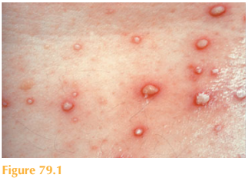History
A 3-year-old boy is noted by his parents to have two small erythematous papules on his abdomen just before bedtime. The next morning he feels hot and has developed multiple lesions over his trunk, some of which look like blisters. Later that day he develops vomit-ing and diarrhoea and his parents take him to the accident and emergency department.
The child has previously been well and attends nursery four days per week. No other family members are obviously affected. His mother feels tired as she is currently 12 weeks pregnant with her third child.
Examination
The child feels hot and looks slightly miserable, he does not obviously look dehy-drated. There are multiple erythematous papules and vesicles over the child’s abdomen (Fig. 79.1), back and around his neck. Most of the vesicles are intact, however some have ruptured and are starting to crust. There are a few excoriation marks around his neck. Mucous membranes are normal.

Questions
• What would be your first course of action?
• What is the most likely diagnosis?
• What investigations might be required?
• What treatment should be offered and to whom?
Chickenpox caused by varicella zoster virus (VZV) is a common, highly contagious infec-tious disease that usually affects young children. In the United States children are vac-cinated against VZV to try to prevent the disease, however this is not routinely given in the United Kingdom as the disease is considered mild. It is also thought that the lower rates of shingles (latent reactivation of VZV in the skin) in adults who themselves had chickenpox as a child results from chronic exposure to the virus through contact with infected individuals. The virus is spread by droplets from the respiratory tract and from infected blister fluid (of chickenpox and shingles). There is usually a history of con-tact with another person with chickenpox/shingles 21 days before symptoms and signs develop. Patients are contagious 2 days prior to the onset of the rash and until all the lesions have completed crusted over.
Chickenpox can cause mild choryzal symptoms, headache, fever and even diarrhoea and vomiting. Small erythematous papules appear in clusters usually on the abdomen initially and then form blisters that appear in crops over a few days spreading outwards across the trunk and limbs. The lesions are classically at different stages: some papules, some blisters, and some crusted lesions starting to heal over. The eruption is usually itchy and many children scratch the tops off the vesicles, which can lead to scars that may be atrophic or keloid.
The first action you should take if assessing a child with potential chickenpox is to move out of the general waiting area/communal areas into a side room. VZV can be potentially serious if transmitted to non-immune, immunocompromised and pregnant individuals. It is important in this case to ascertain if the mother herself has previously had chickenpox as she is currently 12 weeks pregnant. Serology tests can look for rising titres of antibod-ies to VZV (IgM) in active disease and signs of life-long immunity (IgG) to VZV. Blister fluid can be analysed by polymerase chain reaction for the virus in those with the rash.
VZV acquisition in pregnancy can lead to maternal pneumonia, premature labour, and even maternal death. Fetuses and newborns infected with primary VZV often develop very severe disease. Non-immune pregnant women exposed to VZV should be given varicella zoster immune globulin within 96 hours of exposure.
Children with severe chickenpox – that is, 300–500 lesions on a background of atopic eczema – may occasionally need treatment with aciclovir. Mild topical steroids should be restarted once the lesions are starting to crust over to help reduce inflammation, exac- erbation of eczema and possible scarring. VZV remains latent in the body for life in the sensory dorsal root ganglion where reactivation results in shingles in distribution of the sensory cutaneous nerve (dermatome). Acute shingles can be very painful and even after healing can result in post-herpetic neuralgia.
KEY POINTS
• Chickenpox is caused by exposure to VSV and has an incubation period of 21 days.
• Crops of blisters appear on the trunk over several days.
• Non-immune at-risk individuals (pregnancy, immunocompromised) exposed to VZV may need aciclovir or zoster immune globulin.
need an explanation for this answer? contact us directly to get an explanation for this answer